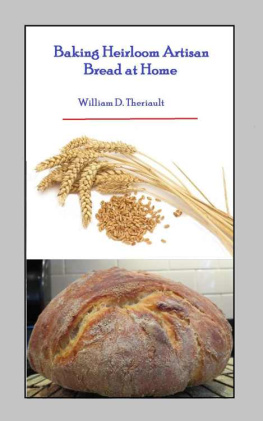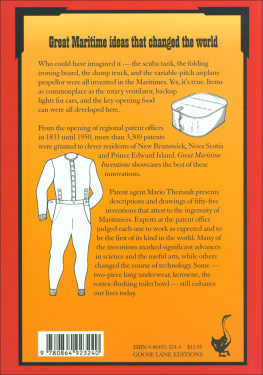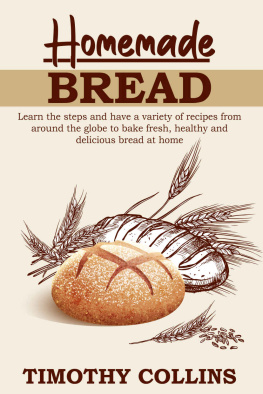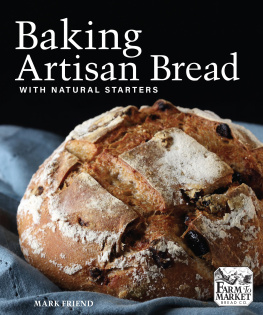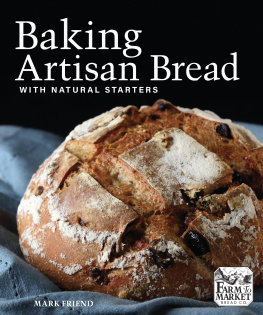Theriault - Baking Heirloom Artisan Bread
Here you can read online Theriault - Baking Heirloom Artisan Bread full text of the book (entire story) in english for free. Download pdf and epub, get meaning, cover and reviews about this ebook. year: 2015, genre: Home and family. Description of the work, (preface) as well as reviews are available. Best literature library LitArk.com created for fans of good reading and offers a wide selection of genres:
Romance novel
Science fiction
Adventure
Detective
Science
History
Home and family
Prose
Art
Politics
Computer
Non-fiction
Religion
Business
Children
Humor
Choose a favorite category and find really read worthwhile books. Enjoy immersion in the world of imagination, feel the emotions of the characters or learn something new for yourself, make an fascinating discovery.
- Book:Baking Heirloom Artisan Bread
- Author:
- Genre:
- Year:2015
- Rating:4 / 5
- Favourites:Add to favourites
- Your mark:
- 80
- 1
- 2
- 3
- 4
- 5
Baking Heirloom Artisan Bread: summary, description and annotation
We offer to read an annotation, description, summary or preface (depends on what the author of the book "Baking Heirloom Artisan Bread" wrote himself). If you haven't found the necessary information about the book — write in the comments, we will try to find it.
Baking Heirloom Artisan Bread — read online for free the complete book (whole text) full work
Below is the text of the book, divided by pages. System saving the place of the last page read, allows you to conveniently read the book "Baking Heirloom Artisan Bread" online for free, without having to search again every time where you left off. Put a bookmark, and you can go to the page where you finished reading at any time.
Font size:
Interval:
Bookmark:
BakingHeirloom Artisan Bread
By William D. Theriault
Textcopyright 2015 William D. Theriault
AllRights Reserved
Contents
What is Artisan Bread?
Go into a bakery or supermarket today, and youll probablyencounter the word artisan" associated with some bread product."Artisan" can have a number of meanings, ranging from a suggestionthat it is a natural food with a variety of health benefits to a promise thatit is an exact replica of the food our ancestors ate.
From an historical perspective, artisan bread is made byhand in a way that was traditional in Europe and Britain from the Middle Ages untilthe Industrial Revolution. It was brought to America with the colonists andproduced here extensively until the 1820s. Specifically, this means that thebread is produced using flour, water, salt, and a culture derived from wildyeast. It is mixed by hand, allowed to rise naturally over an extended period,and baked in a wood-fired masonry oven -- or in a fireplace using a Dutch Ovenor similar container. By implication, this type of artisan bread is free frompreservatives and other artificial ingredients that make it rise quicker, lastlonger, or look prettier. By the time of the Civil War, new technology and massproduction techniques had generally replaced artisan bread with a product thatlooked and tasted much different.
I use the phrase "heirloom artisan" tocharacterize bread baking that uses these traditional, pre-industrialtechniques. This approach has several merits. First, for thestudent of history, it helps you understand our ancestors' way of life by doingsomething the way they did. For the aspiring bread baker, it encouragesyou to bake using all of your five senses, rather than relying heavily onprepackaged ingredients and automated processes. For environmentalists,it helps you create healthy food inexpensively, free from additives, using lessenergy. For survivalists, it can help you make life-sustaining food when youare off the grid.
There are other approaches to baking artisan bread that usemodern equipment and ingredients as well as time-saving processes. Thesechanges make the baking process more efficient and reliable, and they arewidely used in commercial bakeries that produce artisan bread. Both thetraditional and modern approaches to baking artisan bread have their merits anddrawbacks.
This book helps you learn how to make heirloom artisan breadat home, with simple, inexpensive utensils and ingredients. If you gethooked on this kind of baking, maybe you'll want to take another step, back inhistory, and learn how to bake this kind of bread in a colonial style wood-firedbrick oven. But that's another topic for those who have mastered thebasics and are ready for new challenges.
Bill Theriault
What is Heirloom Artisan Bread?
Created with fresh starter made from a wild yeastculture (not from dry quick-rising yeast)
Uses flour, salt, and water as its major ingredients
Mixed by hand
Rises slowly over several hours
Baked in masonry oven, Dutch oven, or cloche
Characteristics of Artisan Bread
Multi-colored crust ranging from tan to dark brown
Top slashed to prevent air pockets forming under crust
Thick, brown, chewy, flavorful crust
Crumb has substantial structure and irregular airpockets
Basic Classes of Wheat Grown in the United States
Growing Season
Winter wheat is planted in the fall and harvested inlate spring or early summer.
Spring wheat is planted in the spring and harvested inearly fall.
Color
Red wheat contains a slightly bitter tasting pigment
White wheat does not contain the pigment; it has amilder taste
Hardiness
Hard wheat contains more protein
Soft wheat contains less protein
Types of Wheat
Hard Red Winter Wheat: Moderate protein content,used for breads, rolls, all-purpose flour.
Hard Red Spring Wheat: The highest-protein breadwheat, made into bread flour.
Soft Red Winter Wheat: Low protein wheat, usedfor pastries, flatbreads, and crackers.
Hard White Wheat: Similar to Hard Red WinterWheat, but with pigment production bred out. Used to make milder-tasting wholewheat products such as bread, rolls, bulgur, and tortillas.
Durham Wheat: Very hard high-protein wheat, usedto make semolina flour for pasta.
Note: The sources noted in section 10.Bibliographyhave been used to provide this information.
I teach folks how to make heirloom artisan bread, usingtraditional ingredients and techniques. Students often wantto know if they can substitute one ingredient for another, use modernappliances, and speed up the process so it will fit into their busylifestyle.
With artisan bread, as with many things in life, what youget out of it depends on what you put into it. My advice is simple: learnhow to make it by hand, understand the how and why, and experience the taste,smell, and feel of the finished product. Realistically, that will take afew weeks of flying solo, recording what you did and how you did it, andlearning from your successes and failures.
At that point, you will know what you gain or lose by modificationand whether it is worth continuing the journey. Let the journey begin.
This chapter focuses exclusively on baking bread using wheatflour. Although you can experiment with different types of flour madefrom different varieties of wheat, the preparation and baking process willremain uniform throughout. Most readers are surprised by how their choiceof flours can affect the finished product.
Understanding the anatomy of a wheat seed is the key toknowing how various types of flour will perform.

The outer protective shell or bran, includes fiberand often pigment. Hard Red Winter Wheat is the variety mostfrequently used to make bread flour, and the bran contains a red pigment thatgives its flour a distinctive "wheaty" flavor. A variety knowas Hard White Winter Wheat lacks the red pigment. Its flour has amilder flavor but is otherwise identical to the red variety.
The inner endosperm includes carbohydrates andproteins. When some of these proteins are combined during the mixingprocess, they form gluten, an elastic ingredient that traps the carbondioxide and alcohol produced by the yeast as it digests thecarbohydrates.
Bread flour contains more gluten-making proteins thanall-purpose flour. Without them, bread won't rise as high or have thechewy texture and open structure found in artisan bread. Unfortunately,some flour manufacturers label their all-purpose product "breadflour" even though it lacks the protein needed for a high rise and astrong structure. You can use it to make bread, but it will NOT rise ashigh or have the same texture.
When you have made heirloom artisan bread using high glutenflour, you may want to try the same recipes using all purpose flour. Personally, I sometimes substitute one kind of flour for another todeliberately change the taste or texture. Colonial bakers used the flouravailable in their area, so results probably varied from one region to another.
Fortunately, flour sold in the United States must contain alist of ingredients, and it's easy to determine if it can be used to makeartisan bread. Typically, the ingredients list contains the weight of aserving size (for example, 30 g) and the protein content of the serving. The protein content should be 4 g or higher. Some labels might list onlythe percentage of protein, but it's easy to do the math for yourself:
Font size:
Interval:
Bookmark:
Similar books «Baking Heirloom Artisan Bread»
Look at similar books to Baking Heirloom Artisan Bread. We have selected literature similar in name and meaning in the hope of providing readers with more options to find new, interesting, not yet read works.
Discussion, reviews of the book Baking Heirloom Artisan Bread and just readers' own opinions. Leave your comments, write what you think about the work, its meaning or the main characters. Specify what exactly you liked and what you didn't like, and why you think so.

